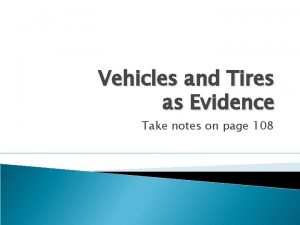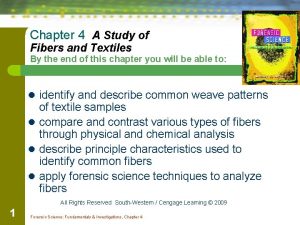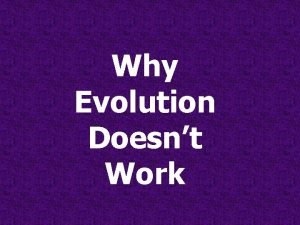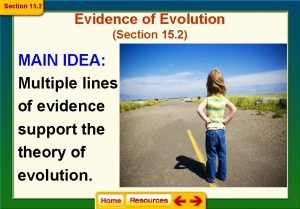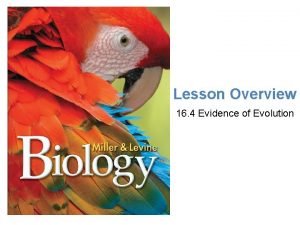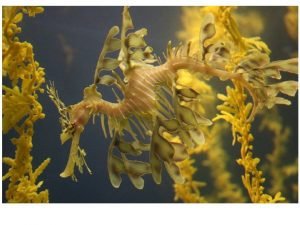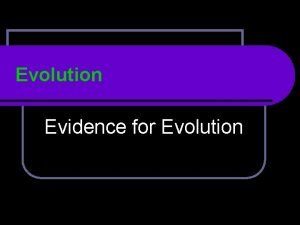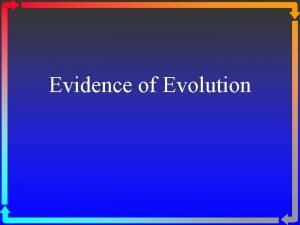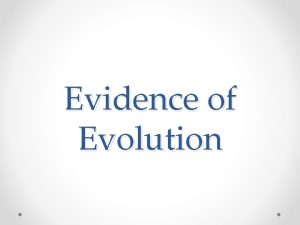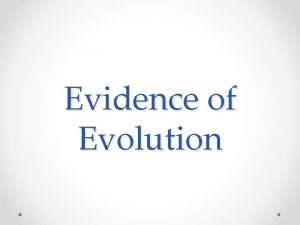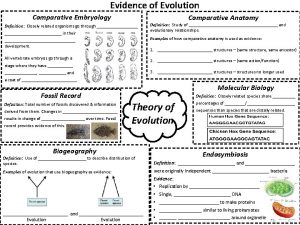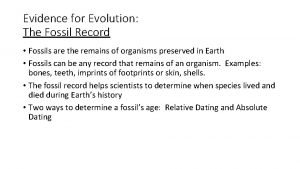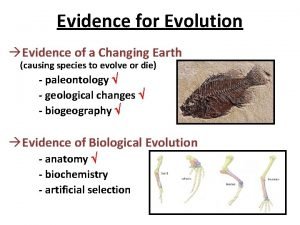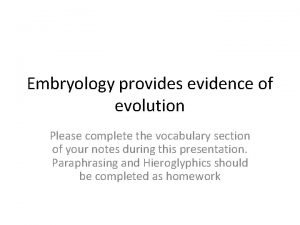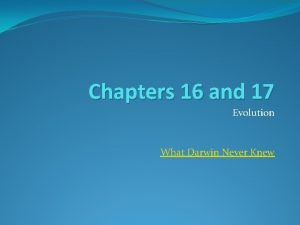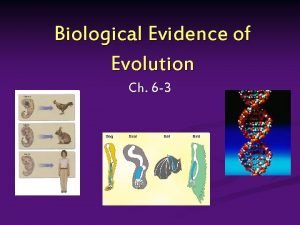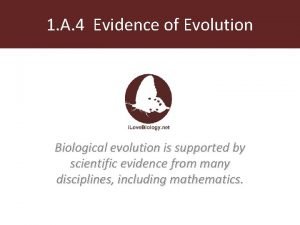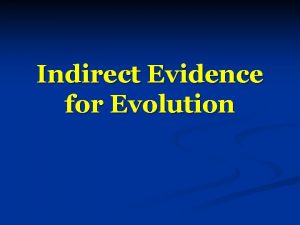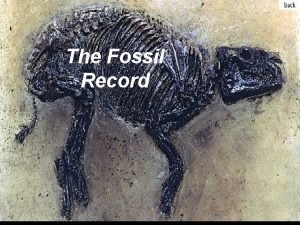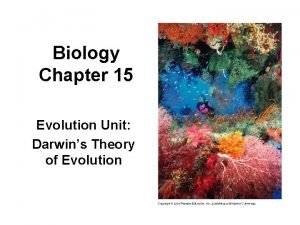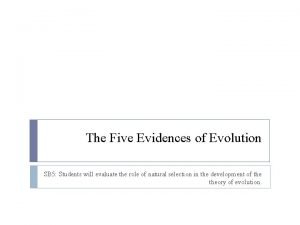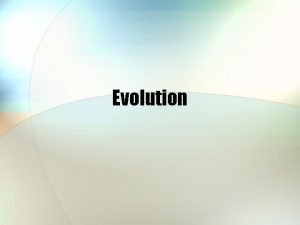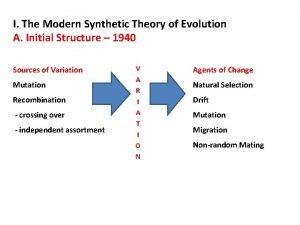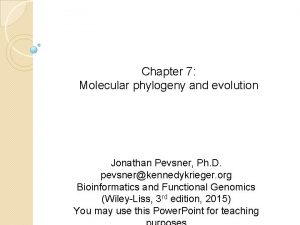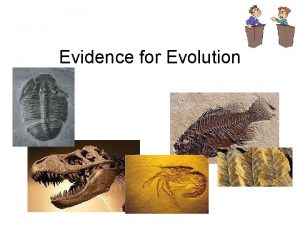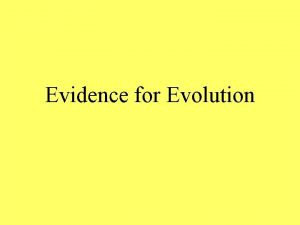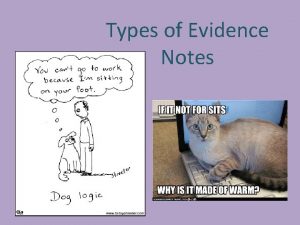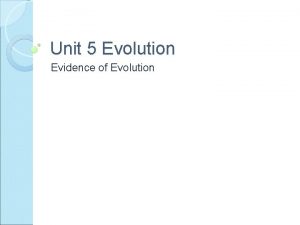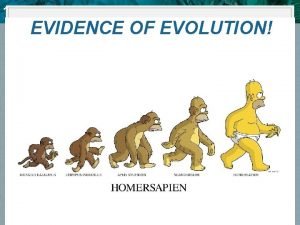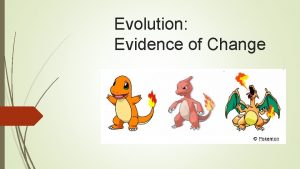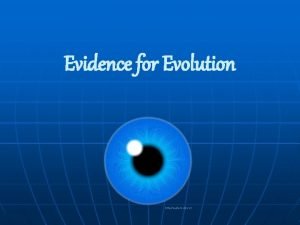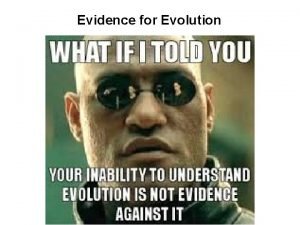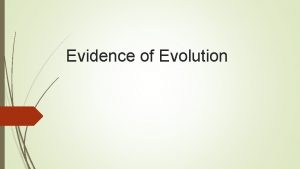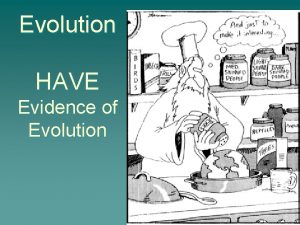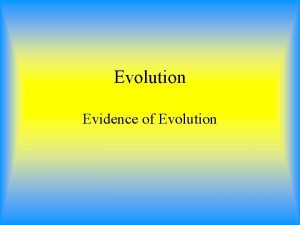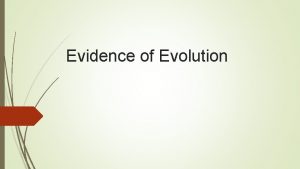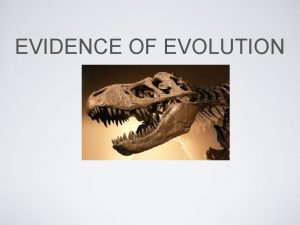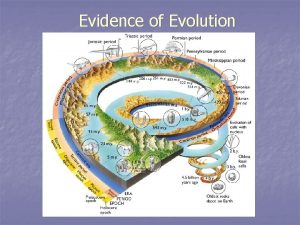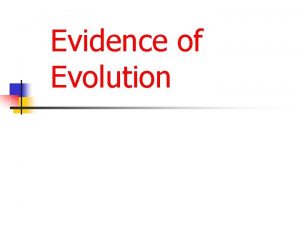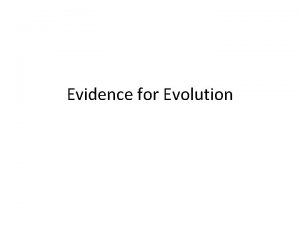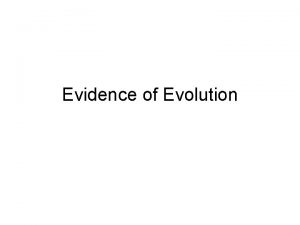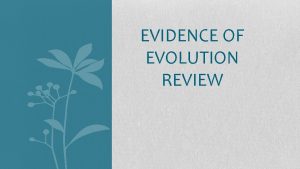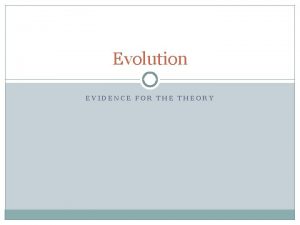Evolution Notes Unit 7 Evolution Evidence of Evolution






































- Slides: 38

Evolution Notes Unit 7

Evolution Evidence of Evolution Support for Evolution § The fossil record § Provide a record of species that lived long ago. § Show that ancient species share similarities with species that now live. Glyptodont Armadillo

Homologous Structures § Anatomically same structures with a different function. § inherited from a common ancestor

Evolution Analogous Structures § Same function but different structure § NOT inherited from common ancestor.

Evolution Evidence of Evolution Vestigial Structures § Structures that are the reduced forms of functional structures in other organisms. § Evolutionary theory predicts that features of ancestors that no longer have a function for that species will become smaller over time until they are lost.

Evidence of Evolution 3. Embryology • Closely related species will have more similarities/ less differences in their stages of embryological development. • Distantly related species will show less similarities/ more differences in their stages of embryological development.

Evidence of Evolution 4. Molecular evidence: DNA • The more closely related you are, the more similar the DNA-BEST evidence!! • DNA RNA PROTEIN!

Evolution Chapter 15 15. 2 Evidence of Evolution Support for Evolution § Geographic Distribution § The distribution of plants and animals that Darwin saw first suggested evolution to Darwin. Rabbit Mara

Chapter 15 Evolution 15. 2 Evidence of Evolution § Comparisons of the similarities in organisms are seen in comparative anatomy and in the fossil record. § Organisms with closely related morphological features have more closely related molecular features.

More Terms • Fitness – ability of an individual to survive and reproduce in a specific environment • Adaptation – inherited characteristic that increases an organism’s chance of survival – Can be physical traits as well as behavioral traits – Behavioral • Birds’ calls Mating dances and migration

Physical Adaptation: Camouflage § Allows organisms to become almost invisible to predators Leafy sea dragon

Physical Adaptation-Mimicry § One species evolves to resemble another species. Western coral snake California kingsnake

Chapter 15 Evolution 15. 2 Evidence of Evolution Camouflage § Allows organisms to become almost invisible to predators Leafy sea dragon

Chapter 15 Evolution 15. 2 Evidence of Evolution Mimicry § One species evolves to resemble another species. Western coral snake California kingsnake

Chapter 15 Evolution 15. 3 Shaping Evolutionary Theory Natural Selection § Acts to select the individuals that are best adapted for survival and reproduction

Chapter 15 Evolution 15. 3 Shaping Evolutionary Theory § Stabilizing selection operates to eliminate extreme phenotypes when the average phenotype leads to higher fitness. § Ex. Siberian Husky-medium height and build helps them do their job in the snow!

Chapter 15 Evolution 15. 3 Shaping Evolutionary Theory § Directional selection makes an organism more fit. § Favors the ONE extreme phenotype § Ex. Greyhound Dog-bred for extreme speed!

Chapter 15 Evolution 15. 3 Shaping Evolutionary Theory § Disruptive selection is a process that splits a population into two groups. § Example: In an environment with BOTH black and white rocks…. § White and Black rabbit lives, but grey rabbit dies

What is a gene pool? • Gene pool – combined genetic info of all members of a population – Contains two of more alleles (genes) for the same trait – Allele frequency – number of times an allele occurs in a gene pool compared to the number of times another allele occurs (expressed in percents)

Gene Flow • Genes entering or leaving a population • AKA. Migration – Emigration Genes LEAVING a population – Immigration INCOMING genes in a population

Chapter 15 Evolution 15. 3 Shaping Evolutionary Theory Founder Effect § The loss of genetic variation that occurs when a new population is established by a very small number of individuals from a larger population Island 1 Island 2 Mainland Island 3

Evolution 15. 3 Shaping Evolutionary Theory Bottleneck § a significant percentage of a population or species is killed or otherwise prevented from reproducing and can rebound later § Often caused by a natural disaster

Chapter 15 Evolution 15. 3 Shaping Evolutionary Theory Mechanisms of Evolution § Population genetics § Hardy-Weinberg principle states that when allelic frequencies remain constant, a population is in genetic equilibrium.

Chapter 15 Evolution 15. 3 Shaping Evolutionary Theory

Chapter 15 Evolution 15. 3 Shaping Evolutionary Theory Genetic Drift § A change in the allelic frequencies in a population that is due to chance and random mating § In smaller populations, the effects of genetic drift become more pronounced, and the chance of losing an allele becomes greater.

Hardy-Weinberg Principle Two Equations: p 2 + 2 pq + q 2 = 1 AND (HD + Hetero + HR=1) • p = frequency of dominant allele (A) • q = frequency of recessive allele (a) • p + q =1 p 2 = frequency of Homozygous Dominant genotype (AA) – (% of Homozygous Dominant individuals in the population) • 2 pq = frequency of heterozygous genotype (Aa) – (% of Heterozygous individuals) • q 2 = frequency of Homozygous Recessive genotype (aa) – (% of Homozygous Recessive individuals)

Hardy-Weinberg Principle Practice: • If 98 out of 200 individuals in a population express the recessive phenotype, what percentage of the population would you predict to be heterozygotes? • (1) I have given you information on the frequency of the homozygous recessive (or q 2). So start by determining q 2 and then solving for q. • • q 2 = (98/200) = 0. 49 (or 49%) q = square root of 0. 49 = 0. 7 (70%)

Hardy-Weinberg Principle • (2) Now that you have q, you can solve for p. Remember there are only two alleles in the population, so if you add the frequency of the two alleles, you have accounted for all possibilities and it must equal 1. So p + q = 1. • • p = 1 -q p = 1 - 0. 7 = 0. 3 (30%)

Hardy-Weinberg Principle • • • (3) Now that you have figured out the % of heterozygotes, can you figure out the % of homozygous dominant? Does the % of homozygous dominant, heterozygotes and homozygous recessive individuals add up to 100%? If not, you have made an error. Those are the only three genotypes possible with only two alleles and a simple dominant and recessive relationship. p 2 = (0. 3) = 0. 09 (or 9%)

Hardy-Weinberg Principle • • (4) Now what is the formula for heterozygotes? Think back to the Hardy-Weinberg equation -- it is dealing with the genotypes of individuals in the population. p 2 + 2 pq + q 2 = 1 so. . . 2 pq = frequency of heterozygotes = 2 (0. 3)(0. 7) = 0. 42 or 42% Now, plug in all of your numbers and make sure they equal 1!! p 2 + 2 pq + q 2 = 1 0. 09 + 0. 42 + 0. 49 = 1. 0

Chapter 15 Evolution 15. 3 Shaping Evolutionary Theory Coevolution § The relationship between two species might be so close that the evolution of one species affects the evolution of the other species. § Mutualism

Chapter 15 Evolution 15. 3 Shaping Evolutionary Theory Convergent Evolution § Unrelated species evolve similar traits even though they live in different parts of the world. Divergent Evolution § Closely related species evolve DIFFERENT traits because of different environments.

Chapter 15 Evolution 15. 3 Shaping Evolutionary Theory Allopatric Speciation § A physical barrier divides one population into two or more populations. Abert squirrel Kaibab squirrel

Chapter 15 Evolution 15. 3 Shaping Evolutionary Theory Sympatric Speciation § A species evolves into a new species without a physical barrier. § The ancestor species and the new species live side by side during the speciation process. Allopatric speciation Sympatric speciation

Chapter 15 Evolution 15. 3 Shaping Evolutionary Theory § Prezygotic isolation prevents reproduction by making fertilization unlikely. • In behavioral isolation, patterns of courtship may be different. • In temporal isolation, different groups may not be reproductively mature at the same season, or month, or year. • In ecological isolation, not in the same habitat where they are likely to meet. • In geographical isolation, a physical barrier(river, stream, canyon) prevents them from mating. Eastern meadowlark and Western meadowlark

Chapter 15 Evolution 15. 3 Shaping Evolutionary Theory § Postzygotic isolation occurs when fertilization has occurred but a hybrid offspring cannot develop or reproduce. § Prevents offspring survival or reproduction Liger

Chapter 15 Evolution 15. 2 Evidence of Evolution § Derived traits are newly evolved features, such as feathers, that do not appear in the fossils of common ancestors. § Ancestral traits are more primitive features, such as teeth and tails, that do appear in ancestral forms.

Chapter 15 Evolution 15. 3 Shaping Evolutionary Theory Adaptive Radiation § Can occur in a relatively short time when one species gives rise to many different species in response to the creation of new habitat or some other ecological opportunity
 Evidence for evolution doodle notes
Evidence for evolution doodle notes Secondary sources
Secondary sources Primary evidence vs secondary evidence
Primary evidence vs secondary evidence Secondary sources
Secondary sources Primary evidence vs secondary evidence
Primary evidence vs secondary evidence Primary evidence vs secondary evidence
Primary evidence vs secondary evidence How can class evidence have probative value
How can class evidence have probative value Class vs individual evidence
Class vs individual evidence How can class evidence be useful
How can class evidence be useful Class and individual evidence
Class and individual evidence Ecologic fallacy
Ecologic fallacy Chapter 4 a study of fibers and textiles worksheet answers
Chapter 4 a study of fibers and textiles worksheet answers Unit 6 review questions
Unit 6 review questions Evidence of evolution
Evidence of evolution Section 15-2 review evidence of evolution
Section 15-2 review evidence of evolution Embryological
Embryological Bottleneck effect
Bottleneck effect Embryology evidence
Embryology evidence What are the 4 types of evidence for evolution
What are the 4 types of evidence for evolution Analogous structures
Analogous structures 4 types of evidence
4 types of evidence Definition of comparative embryology
Definition of comparative embryology Evidence of fossil record
Evidence of fossil record Evidence of evolution stations
Evidence of evolution stations Lamarckian evolution
Lamarckian evolution Embryology evidence of evolution
Embryology evidence of evolution Embryology evidence of evolution examples
Embryology evidence of evolution examples Charles darwin
Charles darwin Biological evidence of evolution
Biological evidence of evolution Evidence of evolution
Evidence of evolution Fish tail bird
Fish tail bird Indirect evidence of evolution
Indirect evidence of evolution Evidence of evolution of remnants and impressions *
Evidence of evolution of remnants and impressions * Molecular biology evidence of evolution
Molecular biology evidence of evolution 5 evidence of evolution
5 evidence of evolution Evolution berkeley
Evolution berkeley Wisc
Wisc Synthetic theory
Synthetic theory Neutral theory of molecular evolution notes
Neutral theory of molecular evolution notes
